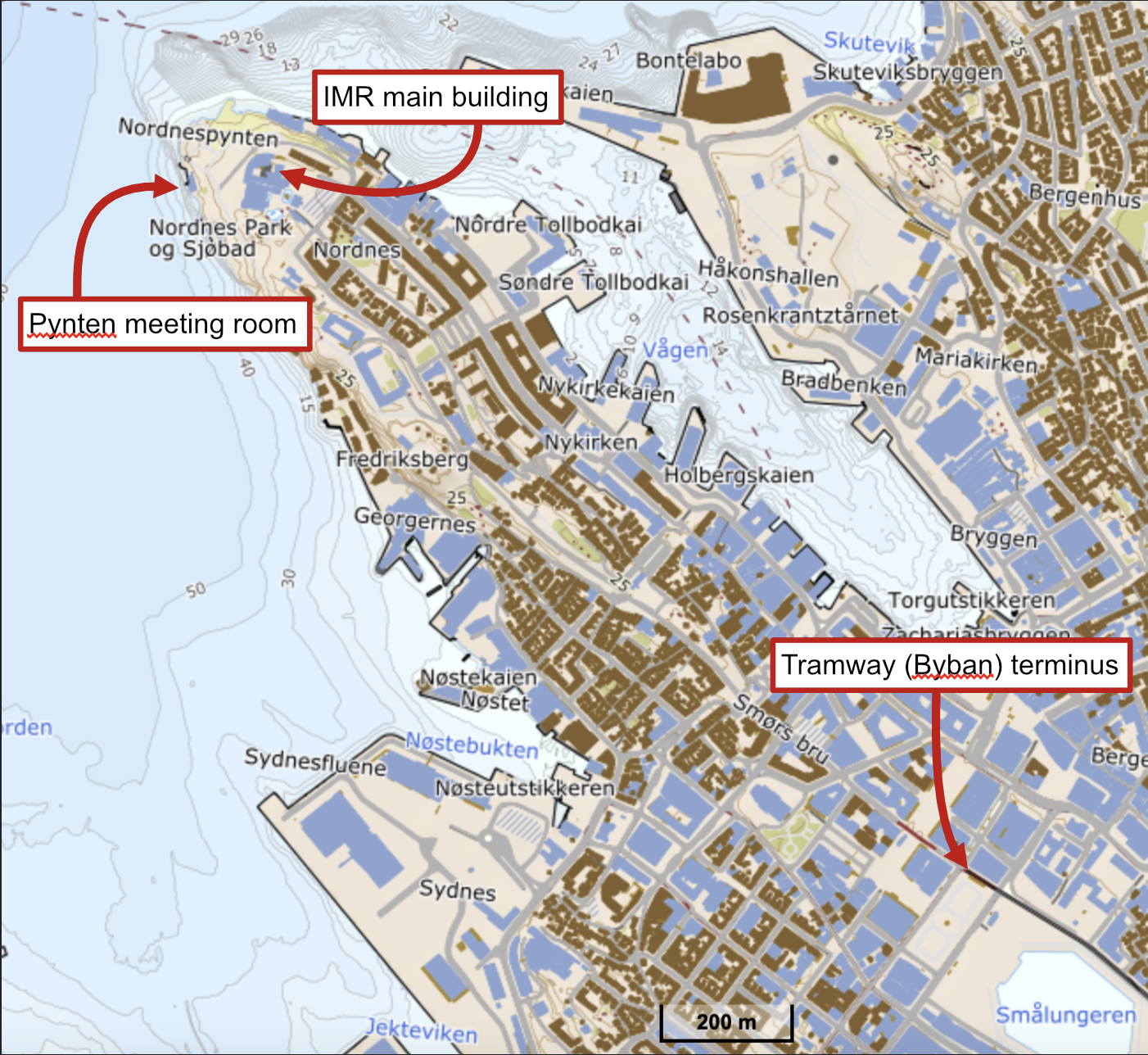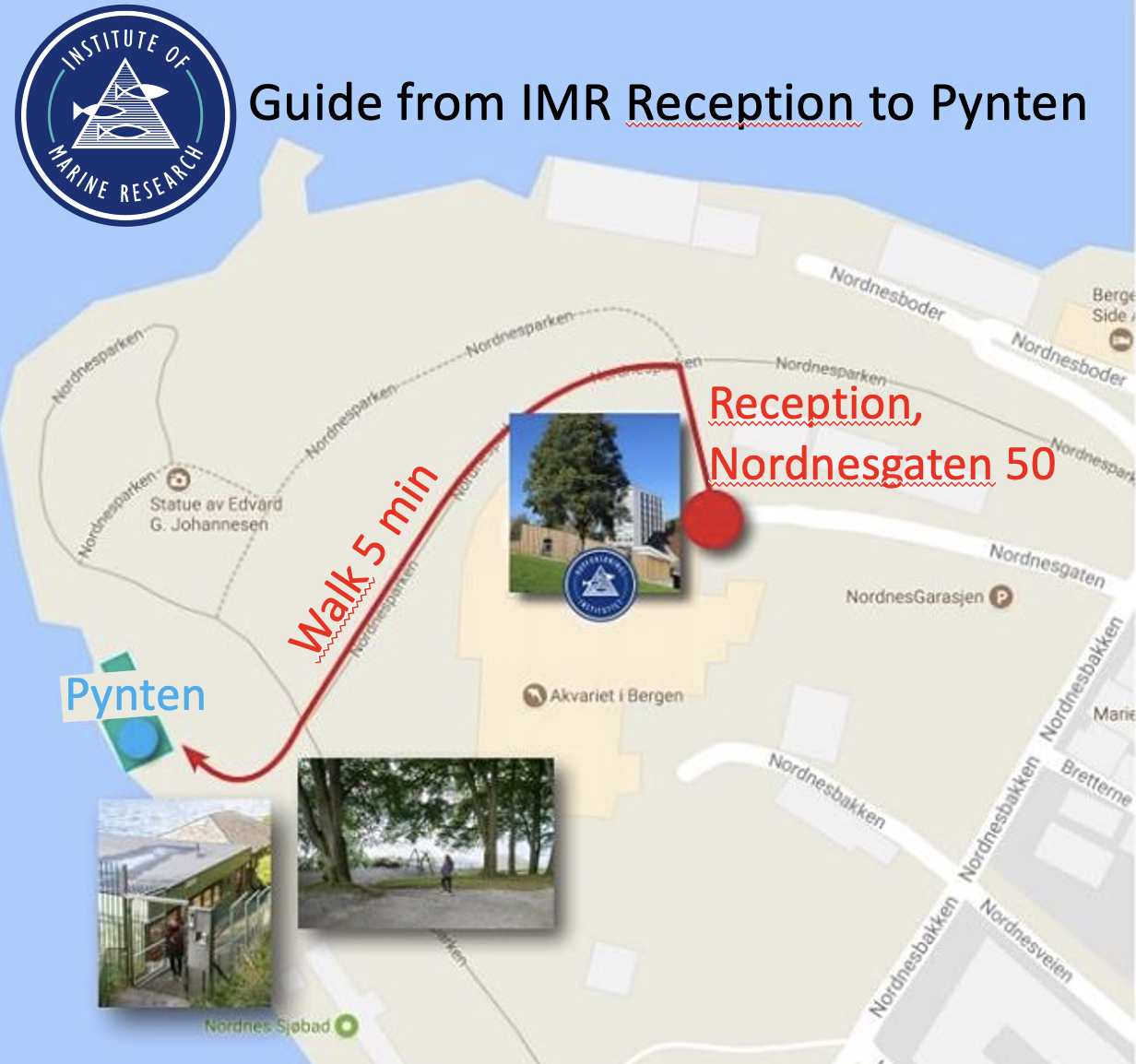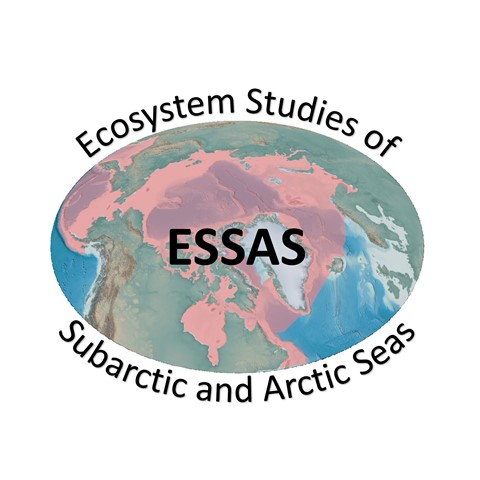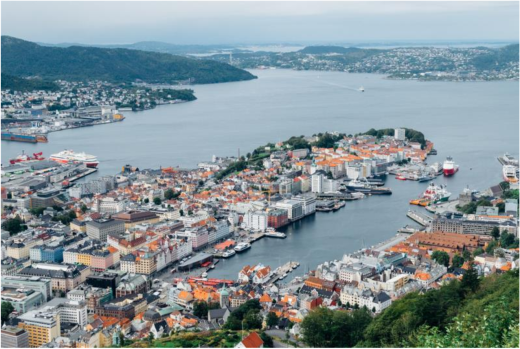Venue & Location: Institute of Marine Research (IMR), meeting room Pynten, Bergen, Norway
Mode: Hybrid in-person / online meeting. We are making arrangements for an in-person meeting for those who are able to attend, but welcome submissions for remote presentations from anyone interested in participating and sharing their research. We are setting the meeting facilities to make the hybrid conference format work as effectively as possible.
Accommodations: We have pre-booked 30 rooms in 2 hotels near the IMR conference facility. Hotel prebooking will be held until 28 May. If you book a room after this date, you will no longer be able to use the prebooking agreements.
Single room 1490 NOK per room per night
Double room 1690 NOK per room per night
There are 15 rooms available. If you are traveling with someone and wish to share accommodations, please specify a double room. Reference number is 11869. Group name is Havforskningsintituttet. Send your order to co.bergen@choice.no or call reception +47 55 30 42 00 if you have any questions. Always refer to the reference number and group name.
Single room 1790 NOK per room per night
Double room 1990 NOK per room per night
There are 15 rooms available. If you are traveling with someone and wish to share accommodations, please specify a double room. Reference number is 23152. Group name is Havforskningsintituttet. Send your order to cl.bergen@choice.no or call reception +47 55 23 64 00 if you have any questions. Always refer to the reference number and group name.
Information about how to get from Bergen Airport (Flesland) to Bergen City:
The cheapest option is to take the Bergen Light rail called Bybanen. It leaves right outside the airport, on the below ground level. Takes about 45 minutes and departs every 5-10 minutes. You can buy a ticket with a credit card or cash at the machine in the arrival hall, outside or at the platform, or with your mobile phone using the app called “Skyss billett”. Buy a ticket for Sone A and the price is 40 NOK one way. The line to and from the airport is line 1. The last stop is the city center of Bergen.
Option 2 is the airport bus called Flybussen (airportbus). It also departs right outside on ground level. You can buy a ticket online or with the driver. If you buy online the stops are called Bergen lufthavn Flesland (the airport) and Festplassen (this is in the center of town) https://www.flybussen.no/en. It takes 30 minutes into town The price is 149 NOK online one way or 258 NOK return ticket. You choose your departure time when buying online but you can travel on the departure that suits you best, the day and the route that you bought the ticket. It is more expensive to buy a ticket from the driver.
Option 3 Taxi. They also depart right outside the airport at ground level. There are several taxi companies. The company 07000 (Bergen Taxi) has a max price ranging between 400-500 NOK depending on the time and day of the week for a ride to town. The ride will take between 20-30 minutes
Information about how to get from IMR to the meeting room Pynten
The main building of IMR (called Høyblokken) is located at the end of the Bergen area called Nordnes. It’s a tall building with the IMR logo on it, hard to miss. From there, you can walk in the park towards the meeting room Pynten. It should take max 5 minutes.


Maps to the meeting room and reception.
Travel support: We have a limited amount of funding to support conference travel for Early Career Scientists who plan to present a talk or poster. To qualify as an Early Career Scientist, you must be under 35 years old OR be either a PhD candidate or have completed your PhD within the last 5 years. You must attend the full conference to be reimbursed for the agreed amount. To apply for funding, please indicate so on the registration form.
Ecological, social, and economic dynamics of high-latitude coastal systems
Sessions (June 20-22) and Workshop (June 19)
Session 1: Cooperative studies of coastal ecosystems engaging local communities in the sub-Arctic and Arctic
Session 2: Natural disasters, multiple stressors and cumulative impacts along sub-arctic and arctic coasts
Session 3: Blue Carbon, mariculture and climate change mitigation and adaptation in the Subarctic and Arctic
Session 4: Cod and climate change at the coastal interface
Workshop (June 19): AnalogueART – Using natural analogues to investigate the effects of climate change on northern ecosystems; moving from gradient to mosaic approaches
Session descriptions
Session 1: Cooperative studies of coastal ecosystems engaging local communities in the sub-Arctic and Arctic
Unprecedented environmental change in the Arctic and sub-Arctic have meant rapid expansion of scientific studies, necessitating increased engagement with local communities. Across the circumpolar north, the ways in which cooperative research with communities is undertaken under the auspices of knowledge co-production, participatory action research, and transdisciplinary science have implications for the way science is done, the ways results are used to inform decision-making, and the social and economic impacts that can be realized from community adaptation and innovation. In this session, cooperative studies taking place in countries around the circumpolar North in subarctic and arctic regions will be featured, with a focus on collaboration and co-production in coastal marine environments in the context of climate change. Key issues that speakers will explore include equitable exchange and boundary spanning in knowledge co-production, implications of Indigenous rights and data sovereignty for design and implementation of participatory studies, intersections of knowledge and power in resource stewardship and governance, and community engagement in paleoecology and archaeology studies and environmental monitoring. Lessons learned and best practices for engaging in ethical and scientifically sound community-based research will be discussed.
Session Co-chairs: Naomi Harada (University of Tokyo, Japan), Yuki Minegishi (University of Tokyo, Japan), Megan Bailey (Dalhousie University, Canada), Anne Beaudreau (University of Washington, USA)
For more information, contact Naomi Harada
Session 2: Natural disasters, multiple stressors and cumulative impacts along sub-arctic and arctic coasts
Coastal waters are generally highly productive ecosystems harboring important ecological processes, and constitute a major share of the ecosystem services provided by the ocean. The economic development of coastal nations has become increasingly dependent on marine resources and maritime activities over the 21st century, a trend which is expected to intensify under the “Blue Economy”. Sustainable management and natural disaster mitigation relies on holistic assessments of how coastal ecosystems respond to or are threatened by pressures from multiple sources ranging from anthropogenic activities to climate change and catastrophic events (e.g. storms, heatwaves, tsunamis). This session considers challenges associated with natural disasters, multiple stressors and cumulative impacts in high-latitude coastal marine ecosystems. We invite presentations on current ecosystem impacts and responses, future perspectives and how to prepare for and manage coastal ecosystems in light of these challenges. Based on submissions, presentations will be divided into sub-sessions of related topics.
Session Co-chairs: Johanna Aarflot (Institute of Marine Reserach, Norway), Hideki Fukuda (University of Tokyo))
For more information, contact Johanna Aarflot
Session 3: Blue Carbon, mariculture and climate change mitigation and adaptation in the Subarctic and Arctic
The development of sustainable aquaculture is critical for future global food security. In arctic and subarctic regions, climate change (e.g. warming, heat waves, ocean acidification, hypoxia, reduced sea ice) brings challenges (and perhaps some opportunities) for sustainable aquaculture development. This session will examine the impacts of climate change on northern aquaculture and how interventions and adaptations by industry (e.g. increased low trophic production for human consumption and fin-fish feed, integrated multi-trophic systems, kelp mariculture/blue carbon, and farm location) can be used to reduce/off-set the carbon and nutrient impact of production and reduce the local effects of climate change on target species.
This session is a collaboration between ESSAS and IMBeR’s Innovation Challenge 5: Interventions to change the course of climate impacts.
Session Co-Chairs: Sam Rastrick (Institute of Marine Research, Norway); Nina Bednarsek (National Institute of Biology, Marine Biological Station, Slovenia; Cooperative Institute for Marine Resources Studies, Oregon State University, USA); Zengjie Jiang (Yellow Sea Fisheries Research Institute, Chinese Academy of Fishery Sciences, China); Ramon Filgueira (Dalhousie University, Canada)
For more information, contact Sam Rastrick
Session 4: Cod and climate change at the coastal interface
Warmer waters and retreating sea ice are altering cod habitat, genetic structure, and recruitment dynamics at the southern and northern extent of their range. Such changes are leading to significant changes in the gadid assemblage that was historically accessible to subsistence fishers, commercial harvesters and survey gear. This session is focused on how these climate-induced changes are impacting habitats and survival potential of cod at the coastal interface (e.g., nurseries, fjords, embayments etc.). We seek contributions that further our understanding of the functional role and changing nature of nursery habitats and the inshore-offshore processes that connect these habitats and impact regional populations. We particularly welcome talks that approach these questions mechanistically and consider emerging patterns in movement, condition and growth that respond to warming and affect the current and future distributions of cod populations.
Session convenors: Benjamin J. Laurel (NOAA Alaska Fisheries Science Center); Franz Mueter (University of Alaska Fairbanks); Guðbjörg Ólafsdóttir (University of Iceland); Halvor Knutsen (Institute of Marine Science, Norway).
For more information, contact Benjamin Laurel
Workshop: AnalogueART – Using natural analogues to investigate the effects of climate change on northern ecosystems; moving from gradient to mosaic approaches.
Northern oceans are in a state of rapid transition. The polar ocean is experiencing one of the most rapid shifts in biogeographic boundaries on the planet due to rapid warming, resulting in polar and tundra ice melt, ocean and coastal acidification, and increased heat waves and hypoxic events – that affect the ecology of marine organisms. Our knowledge on the likely effects of these drivers on northern ocean chemistry and ecosystems is inadequate. It is based mainly on limited oceanographic observations and single-species, rapid perturbation experiments on isolated elements of the ecosystem that focus on a limited number of climate drivers. It is difficult to extrapolate from such studies to larger scales, as these are generally too short-term to reveal how organisms may adapt/acclimatise, have often set steady pCO2 levels (which are unrealistic), and use organisms that are separated from their natural suite of food, competitors, predators, and facilitators.
Natural analogues have been used to further our knowledge on the sensitivity of biological systems to this global change driver. These assess the capacity of different tropical and temperate species for long-term acclimatisation and adaptation to elevated levels of pCO2. Natural analogues have also provided the means to scale-up from single-species responses to community and ecosystem level responses. A range of Arctic and sub-Arctic sites, including CO2 vents, methane cold seeps, estuaries, fjords, up-welling areas and polar fronts, that encompass gradients of temperature, salinity, oxygen pH, carbonate saturation state and alkalinity, are suggested for future high latitude, in-situ climate change research.
Recently there has been growing interest in using more complex environmental mosaics as Natural analogues. Where multiple intersecting gradients in environmental conditions are used to disentangle the effects of multiple drivers (e.g. carbonate chemistry and salinity). Mosaics approaches and a general recognition of the need for a greater spatial and temporal resolution of data within natural analogues studies has led to the application of new methods in monitoring chemical oceanography, physiology, ecology, and statistics.
The aims of the workshop are to:
- Discuss recent advances natural analogue research and the development of Mosaics approaches.
- Discuss the development of new methods in monitoring chemical oceanography, physiology, ecology, and statistics that will help increase the spatial and temporal resolution of data within natural analogues studies.
- Continue to develop best practice guidelines for future research using natural analogues to investigate the effects of climate change
We invite presentations and posters examining these key aims.












